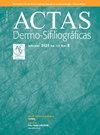Rasch Analysis of the Dermatology Life Quality Index
IF 3.8
Q1 DERMATOLOGY
引用次数: 0
Abstract
Background and aims: Previous results of the Dermatology-Life-Quality-Index (DLQI) validation in Colombia based on the classical test theory (CTT) perspective have showed the need to delve into its measurement properties. Therefore, we aimed to assess the structural validity, internal consistency and item response analysis of the DLQI through the item response theory (IRT) or the Rasch model.
Material and methods: We assessed the dimensionality of the DLQI, determined its difficulty, discrimination and differential functioning and went on to evaluate its internal consistency and discriminative validity among patients with inflammatory and non-inflammatory skin disease. We recruited Colombian patients with different skin diseases.
Results: Data of 865 patients (mean age, 49.3 years; 61% females) were included. DLQI-scores ranged from 0 up to 30. Internal consistency for dichotomous item #7 showed a McDonald's Omega coefficient of 0.85 (95%CI, 0.84-0.87) and a Cronbach's α coefficient of 0.86 (95%CI, 0.84-0.88). For ordinal item #7, the McDonald's Omega coefficient was 0.87 (95%IC:0.85-0.89) and Cronbach's α coefficient, 0.84 (95%CI, 0.82-0.87). Horn's parallel analysis revealed the presence of DLQI unidimensionality with a 1-factor solution. Only item #1 fitted the PCM model. The remaining items, including item #9, did not show adequate fit due to overlapping responses and order changes.
Conclusions: The validity of DLQI-COL based on Rasch analysis proved not to be a suitable instrument to evaluate QoL in our dermatologic population. A refined version of the scale with an adequate cross-cultural adaptation and validation process is needed to obtain an appropriate and reliable version of the instrument for QOL measuring in Colombian patients with skin diseases.
Abstract
Background and aims: Previous results of the Dermatology-Life-Quality-Index (DLQI) validation in Colombia based on the classical test theory (CTT) perspective have showed the need to delve into its measurement properties. Therefore, we aimed to assess the structural validity, internal consistency and item response analysis of the DLQI through the item response theory (IRT) or the Rasch model.
Material and methods: We assessed the dimensionality of the DLQI, determined its difficulty, discrimination and differential functioning and went on to evaluate its internal consistency and discriminative validity among patients with inflammatory and non-inflammatory skin disease. We recruited Colombian patients with different skin diseases.
Results: Data of 865 patients (mean age, 49.3 years; 61% females) were included. DLQI-scores ranged from 0 up to 30. Internal consistency for dichotomous item #7 showed a McDonald's Omega coefficient of 0.85 (95%CI, 0.84-0.87) and a Cronbach's α coefficient of 0.86 (95%CI, 0.84-0.88). For ordinal item #7, the McDonald's Omega coefficient was 0.87 (95%IC:0.85-0.89) and Cronbach's α coefficient, 0.84 (95%CI, 0.82-0.87). Horn's parallel analysis revealed the presence of DLQI unidimensionality with a 1-factor solution. Only item #1 fitted the PCM model. The remaining items, including item #9, did not show adequate fit due to overlapping responses and order changes.
Conclusions: The validity of DLQI-COL based on Rasch analysis proved not to be a suitable instrument to evaluate QoL in our dermatologic population. A refined version of the scale with an adequate cross-cultural adaptation and validation process is needed to obtain an appropriate and reliable version of the instrument for QOL measuring in Colombian patients with skin diseases.

 求助内容:
求助内容: 应助结果提醒方式:
应助结果提醒方式:


